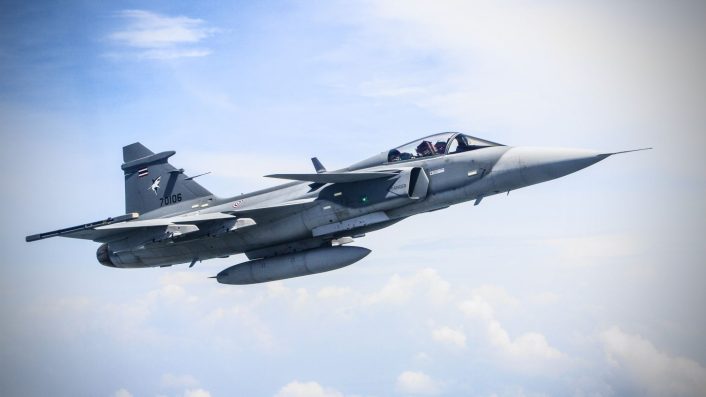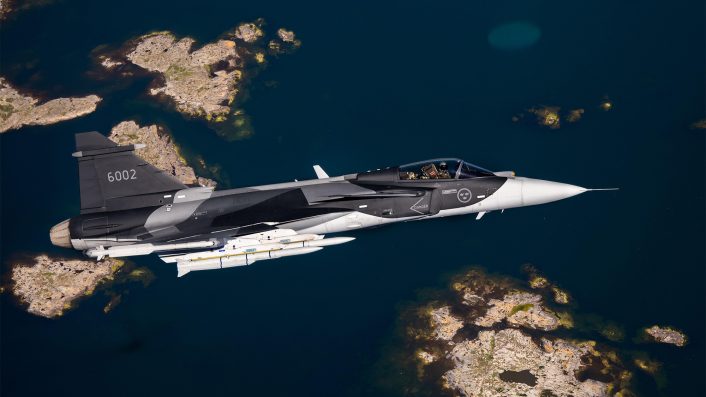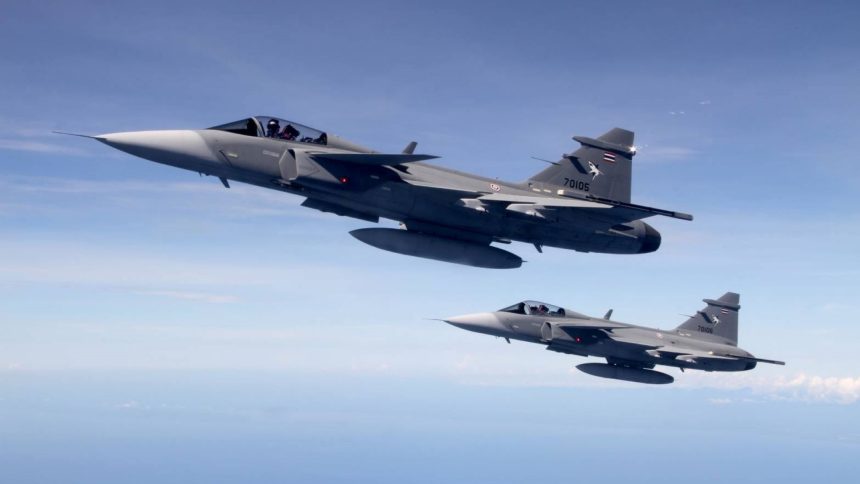The Royal Thai Air Force will be the first user in Asia and the third globally to field the Gripen E.
Thailand and Sweden signed on Aug. 25, 2025, a contract for 12 Saab JAS-39E/F Gripen fighters to be delivered in four batches, with the current deal covering the first batch of four airframes. This comes nearly two-and-a-half months after Saab confirmed on Jun. 4 that the Gripen E has been selected by the RTAF (Royal Thai Air Force).
Signed by the commander of the RTAF, Air Chief Marshal Punpakdee Pattanakul, and the chief of the Swedish Defense Materiel Administration (FMV), Mikael Granholm, in the presence of Thai foreign minister Maris Sangiampongsa and Stockholm’s defense minister Pål Jonson, this contract covers the first phase of the acquisition with three single-seater Gripen Es and a twin-seater Gripen F.
The development also comes after Thai reports mentioned that the RTAF became the first service to use the Gripens in combat late in July, while engaging Cambodian ground positions. It should be mentioned however that the first to be employed in combat were the Swedish Gripens during the operations in Libya, without employing weapons.
The RTAF thus becomes the first Gripen user to employ weapons in combat. The hostilities also saw the RTAF’s F-16 using South Korean KGGB guidance kits applied to Mk-82 gravity bombs.
RELEASE: Saab receives Gripen E/F order for Thailandhttps://t.co/5rYrNaiRpr
— Saab (@Saab) August 25, 2025
The RTAF already operates 12 older Gripen C/D aircraft (four two-seat ‘D’ variants and eight single-seat Cs), fielded between 2011 and 2013. These Gripens are operated by the 701st Fighter Squadron under Wing 7 in the Surat Thani province.
The RTAF announced its preference for the Gripen in August 2024, beating out a Lockheed Martin proposal offering F-16 Block 70/72 Fighting Falcons. The latest contract also makes Thailand the first nation in the Asia Pacific region and the third in the world to operate the newer Gripen E variant, after Sweden and Brazil. Other Gripen users of the Gripen include South Africa, Hungary, Czech Republic and, in future, Colombia.
FM @AmbPoohMaris, together with Sweden’s Defence Minister @PlJonson, witnessed the signing of the 1st-phase procurement contract for Gripen E/F fighter aircrafts and the Offset Policy Agreement, with the Commander of the RTAF representing Thailand as an official signatory. This… pic.twitter.com/cN82kwx5LM
— กระทรวงการต่างประเทศ | MFA of Thailand (@MFAThai) August 25, 2025
Replace older F-16s
Thai Enquirer said that the government-to-government deal for the Gripens will replace the RTAF’s aging F-16s. The service currently operates a mix of F-16 A/B Air Defense Fighter (ADF) models, Northrop F-5E/F/T, and Saab Gripen C/Ds.

The new Gripens are expected to replace the oldest F-16s, which were ordered back in 1987. The oldest airframes are operated by the RTAF’s 102 Squadron based in Korat RTAFB (Royal Thai Air Force Base). These Fighting Falcons will continue operating for about a decade until the transition.
The package also includes ground support equipment, pilot training, electronic warfare systems and long-range air-to-air missiles like the Meteor. Deliveries will start in 2029, with two aircraft per year until the first squadron of 12 airframes is complete.
🇸🇪🇹🇭Today, Sweden and Thailand have signed an agreement on the procurement of 4 JAS Gripen E/F. Thailand wants to buy 12 new fighter jets and Sweden has offered 12 Gripen E/F to Thailand. This is the first contract and more purchases can be set to follow. (1/4) pic.twitter.com/Q2DugvTZF3
— Pål Jonson (@PlJonson) August 25, 2025
In January, the RTAF also evaluated its Gripens in highway operations from dispersed locations, assessing the Swedish jet’s acclaimed inherent Agile Combat Employment (ACE)-friendliness.
The contract
Both the Thai Ministry of Foreign Affairs and Saab mentioned the contract also covers an Offset Policy Agreement, which on a long-term basis offers “significant transfer of defense technology and industrial cooperation with Thailand together with new investments across many sectors of the national economy.
According to a press release from the Swedish government, “more agreements may follow, with the Riksdag authorising the Government to enter into agreements with Thailand on the sale of up to 12 Gripen E/F series.” The offset agreement, according to Thai Enquirer, covers 14 initiatives including “technology transfers such as the Link T tactical data link system for joint operations, as well as investments in the aviation and cyber sectors.”
The Swedish government press release also upheld the importance of local manufacturing for the global Gripen fleet. This in general simplifies logistics in terms of spares, components and keeps costs low.
“Having more partners creates conditions to further develop the Gripen programme,” the press release added. “This improves production capacity and provides new experiences that can be shared among Gripen users.”
Local or regional production also contributes to the domestic economy through jobs, and Saab has been known to market its domestic industry-friendliness. This was also the hallmark of the Gripen deal with Brazil, where the aircraft is produced under a ToT with Embraer. Saab had been pushing to leverage the existing capacity in South America for the new Gripen customer, Colombia.
“This procurement is not only an increase in military security capability, but also an important mechanism for economic, social, educational and technological development of the country,” the RTAF said in a Facebook post.
Like the other Gripen E/Fs, Thailand’s new Gripens will be powered by GE Aerospace’s F414-GE-39E turbofan engines, of which the company says more than 1,600 have been delivered, clocking over 5 million flight hours. The RTAF’s existing Gripen C/Ds fly on GE’s RM12 engines.

Sweden’s defense minister Pål Jonson said the Gripen E/F “combines cutting-edge technology, low operating cost, and high availability.” He further added “this agreement creates long-term capability, a stronger partnership and deeper defense cooperation between Thailand and Sweden.”
In Saab’s press release, its president and CEO Micael Johansson said the company welcomed Thailand as the latest Gripen E/F customer. “Thailand is already a well-established Gripen user and familiar with the strengths that Gripen brings to the Royal Thai Armed Forces. Thailand has chosen the most modern fighter on the market with which to build its next generation of strategic, independent capabilities,” Johansson said.
With 47 F-16A/Bs, 33 F-5E/Fs, 12 Gripens, and 18 Alpha Jets in active service, the Royal Thai Air Force is one of the most capable air arms in Southeast Asia. It’s now facing Cambodia – whose air force is virtually nonexistent. Let’s see how this turns out! pic.twitter.com/LTyQddCX1p
— Air Power (@RealAirPower1) July 24, 2025
Thai Gripens first to use weapons in combat
Maris made a reference to the recent Thai-Cambodia border conflict, saying the Thai military “demonstrated adherence to international law and operational discipline.” As reported by Thai Enquirer, Maris said “Gripen aircraft were deployed without crossing into Cambodian airspace, using precision strikes against military targets.”
WATCH⚡️Reports indicate that Thailand has utilized Swedish-made JAS 39 Gripen fighter jets for the first time to execute air strikes on Cambodian artillery sites, in order to defend two key areas.
This marks the first instance of Gripen aircraft participating in an active… pic.twitter.com/KXhdb1qF0c
— WORLD AT WAR (@World_At_War_6) July 26, 2025
The Bangkok Post said the first time the Swedish-made Gripen C/Ds were used in combat was on Jul. 26, when two of the jets, flying alongside the RTAF’s older F-16s, were used against Cambodian artillery firing on Thai positions along their disputed border.









